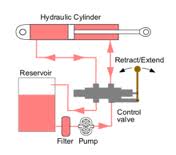Hydraulic Seals
are used to seal in fluids or other media in reciprocating and linear motion applications. The shaft, rod and piston moves backwards and/or forward, in and/or out, up or/and down.
 Hydraulic Seals are designed to…
Hydraulic Seals are designed to…
- Maintain hydraulic pressure
- Retain the lubricant
- Exclude contamination
Hydraulic Seals are grouped as follows…
- Piston Seals

- Rod Seals
- Wiper Seals
- Guide Rings
- O-Rings
- Backup Rings
Wiper Seal
This hydraulic seal is designed to keep contamination out of the hydraulic system. Contamination is the most common reason for breakdowns and the humble wiper seal has an extremely important task to prevent this.
Piston Seal
This hydraulic seal is designed to ensure that pressurised fluid does not leak between the piston and the bore. The piston seal is available both as single and double acting. The ultimate choice of piston seal must be based on the operating conditions.
Rod Seal
This hydraulic seal is designed to ensure that pressurised fluid does not leak out of the equipment as the rod moves back and forth. Rod seals must meet the most demanding specifications due to the fact that leakage through the rod seal can possibly cause accidents and environmental damage.
O-Rings
O-Rings are hydraulic seals. The humble, simple and unique o-ring is used in many different applications. O-Rings are mostly used in static sealing applications but tend to extrude at fairly low pressure. A harder material may help but a backup ring used on one or both sides of the o-ring will improve performance
Guide Rings
The task of the guide ring (and guide strip) is to guide the piston and rod to ensure that there is no metallic contact between mobile parts. Guide strips are made of plastic as this material works more smoothly and has a considerably longer service life that metallic guides.
Backup Rings
The backup ring provides extrusion resistance for an O-ring. The backup is used when the O-ring is subjected to high pressure, large extrusion gaps and high temperatures. Backups can be used on one or both sides of the O-ring dependent on the application.



